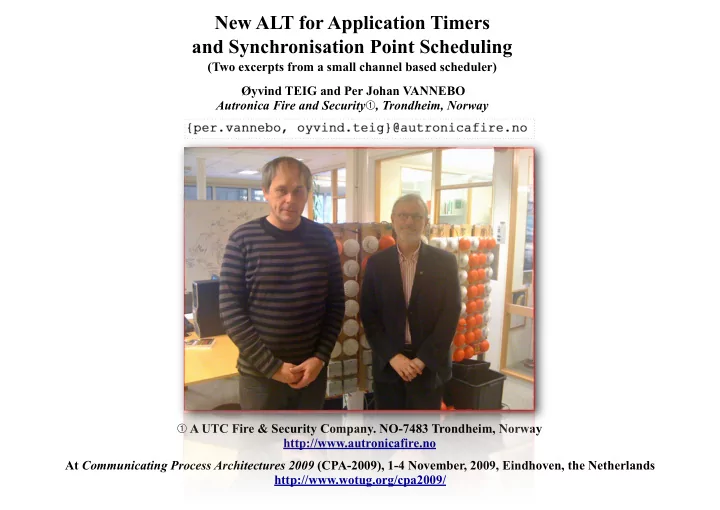

New ALT for Application Timers and Synchronisation Point Scheduling (Two excerpts from a small channel based scheduler) Øyvind TEIG and Per Johan VANNEBO Autronica Fire and Security ➀ , Trondheim, Norway ➀ A UTC Fire & Security Company. NO-7483 Trondheim, Norway http://www.autronicafire.no At Communicating Process Architectures 2009 (CPA-2009), 1-4 November, 2009, Eindhoven, the Netherlands http://www.wotug.org/cpa2009/
ChanSched handling «Extended Commstime»
Application timers aren ’ t as built-in as you think
New ALT for Application Timers.. Void P_Prefix (void) // extended “Prefix” 01 { 02 Prefix_CP_a CP = (Prefix_CP_a)g_CP; // get process Context from Scheduler 03 PROCTOR_PREFIX() // jump table (see Section 2) 04 ... some initialisation 05 SET_EGGTIMER (CHAN_EGGTIMER, CP->LED_Timeout_Tick); 06 SET_REPTIMER (CHAN_REPTIMER, ADC_TIME_TICKS); 07 CHAN_OUT (CHAN_DATA_0, &CP->Data_0, sizeof(CP->Data_0)); // first output 08 while (TRUE) 09 { 10 ALT(); // this is the needed ”PRI_ALT” 11 ALT_EGGREPTIMER_IN (CHAN_EGGTIMER); 12 ALT_EGGREPTIMER_IN (CHAN_REPTIMER); 13 gALT_SIGNAL_CHAN_IN (CHAN_SIGNAL_AD_READY); 14 ALT_CHAN_IN (CHAN_DATA_2, &CP->Data_2, sizeof (CP->Data_2)); 15 ALT_ALTTIMER_IN (CHAN_ALTTIMER, TIME_TICKS_100_MSECS); 16 gALT_END(); 17 switch (g_ThisChannelId) 18 { 19 ... process the guard that has been taken, e.g. CHAN_DATA_2 20 CHAN_OUT (CHAN_DATA_0, &CP->Data_0, sizeof (CP->Data_0)); 21 }; 22 } 23 } 24
25. PROC P_Listing2 (VAL INT n, CHAN INT InChan? OutChan!) -- extended “Prefix” 26. INT Timeout_ALTTIMER, Timeout_REPTIMER: 27. TIMER Clock_ALTTIMER, Clock_REPTIMER: 28. SEQ 29. OutChan ! n 30. Clock_REPTIMER ? Timeout_REPTIMER 31. Timeout_REPTIMER := Timeout_REPTIMER PLUS half.an.hour 32. WHILE TRUE 33. Clock_ALTTIMER ? Timeout_ALTTIMER 34. PRI ALT 35. Clock_REPTIMER ? AFTER Timeout_REPTIMER 36. ... process every 30 minutes 37. Timeout_REPTIMER := Timeout_REPTIMER PLUS half.an.hour 38. -- no skew, only jitter 39. INT Data: 40. InChan ? Data 41. ... process Data 42. Clock_ALTTIMER ? AFTER Timeout_ALTTIMER PLUS hundred.ms 43. ... MyChan pause do background task (starvation possible) 44. -- skew and jitter 45. :
PROC P_Listing3 (VAL INT n, CHAN INT InChan? OutChan!) -- extended “Prefix” 46 TIMER My_ALTTIMER, My_REPTIMER: -- only timers, no variables 47 SEQ 48 OutChan ! n 49 SET_TIMER (REPTIMER, My_REPTIMER, 30, MINUTE, 24H) 50 SET_TIMER (ALTTIMER, My_ALTTIMER, 0, MILLISEC, 32BIT) 51 WHILE TRUE 52 PRI ALT 53 My_REPTIMER ? AFTER () 54 ... process every 30 minutes (no timeout value to compute) 55 -- no skew, only jitter 56 INT Data: 57 InChan ? Data 58 ... process Data 59 My_ALTTIMER ? AFTER (100) 60 ... MyChan pause do background task (starvation possible) 61 -- skew and jitter 62 : 63
A scheduler isn ’ t as invisible as it looks
.. and Synchronisation Point Scheduling PROCTOR_PREFIX void P_Standard (void) void P_Extended (void) { { CP_a CP = (CP_a)g_ThisExtPtr; // Application CP_a CP = (CP_a)g_ThisExtPtr; // Application switch (CP->State) // and // Init here // state only // communication while (TRUE) // state { { switch (CP->State) case ST_INIT: {/*Init*/ break;} { case ST_IN: case ST_MAIN: { { CHAN_IN(G_CHAN_IN,CP->Chan_val1); CHAN_IN(G_CHAN_IN,CP->Chan_val2); CP->State = ST_APPL1; break; } case ST_APPL1: { // Process val1 // Process val2 CP->State = ST_OUT; break; } case ST_OUT: { CHAN_OUT(G_CHAN_OUT,CP->Chan_val1); CHAN_OUT(G_CHAN_OUT,CP->Chan_val2); CP->State = ST_IN; CP->State = ST_MAIN; // option1 break; break; } } } } } } } void P_libcsp2 (Channel *in, Channel *out) PROC P_occam (CHAN OF INT in, out) { int val3; WHILE TRUE for(;;) INT val4: { SEQ ChanInInt (in, &val3); in ? val4 // Process val3 -- Process val4 ChanOutInt (out, val3); out ! val4 } } :
#define SCHEDULE_AT goto 64 65 #define CAT(a,b,c,d,e) a##b##c##d##e // Concatenate to f.ex. “SYNCH_8_L” 66 67 #define SYNCH_LABEL(a,b,c,d,e) CAT(a,b,c,d,e) // Label for Proctor-table 68 69 #define PROC_DESCHEDULE_AND_LABEL() \ 70 CP->LineNo = __LINE__; \ 71 return; \ 72 SYNCH_LABEL(SYNCH,_,__LINE__,_,L): 73 74 #define CHAN_OUT(chan,dataptr,len) \ 75 if (ChanSched_ChanOut(chan,dataptr,len) == FALSE) \ 76 { \ 77 PROC_DESCHEDULE_AND_LABEL(); \ 78 } \ 79 g_ThisAltTaken = FALSE 80 #define PROCTOR_PREFIX()\ 81 switch (CP->LineNo)\ 82 {\ 83 case 0: break;\ 84 case 8: SCHEDULE_AT SYNCH_8_L;\ 85 case 17: SCHEDULE_AT SYNCH_17_L;\ 86 case 21: SCHEDULE_AT SYNCH_21_L;\ 87 DEFAULT_EXIT\ 88 } 89
In P_Commstime.c there were 4 processes, and 10 synchronisation points In P_Timers_Handler.c there was 1 process, and 1 synchronisation point There were a total of 2 files, 5 processes and 11 syncronisation points
..application timers & scheduling..
..questions? http://www.teigfam.net/oyvind/pub/CPA2009/paper.pdf http://www.teigfam.net/oyvind/pub/CPA2009/presentation.pdf
Recommend
More recommend